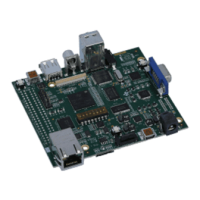Synchronous Serial Interface (SSI)
Note:
The upper 32 - N bits of the ui32Data are discarded by the hardware, where N is the data width
as configured by ROM_SSIConfigSetExpClk(). For example, if the interface is configured for
8-bit data width, the upper 24 bits of ui32Data are discarded.
Returns:
Returns the number of elements written to the SSI transmit FIFO.
17.2.1.9 ROM_SSIDisable
Disables the synchronous serial interface.
Prototype:
void
ROM_SSIDisable(uint32_t ui32Base)
ROM Location:
ROM_APITABLE is an array of pointers located at 0x0100.0010.
ROM_SSITABLE is an array of pointers located at ROM_APITABLE[2].
ROM_SSIDisable is a function pointer located at ROM_SSITABLE[3].
Parameters:
ui32Base specifies the SSI module base address.
Description:
This function disables operation of the synchronous serial interface.
Returns:
None.
17.2.1.10 ROM_SSIDMADisable
Disable SSI DMA operation.
Prototype:
void
ROM_SSIDMADisable(uint32_t ui32Base,
uint32_t ui32DMAFlags)
ROM Location:
ROM_APITABLE is an array of pointers located at 0x0100.0010.
ROM_SSITABLE is an array of pointers located at ROM_APITABLE[2].
ROM_SSIDMADisable is a function pointer located at ROM_SSITABLE[13].
Parameters:
ui32Base is the base address of the SSI port.
ui32DMAFlags is a bit mask of the DMA features to disable.
Description:
This function is used to disable SSI DMA features that were enabled by
ROM_SSIDMAEnable(). The specified SSI DMA features are disabled. The ui32DMAFlags
parameter is the logical OR of any of the following values:
April 8, 2013 191

